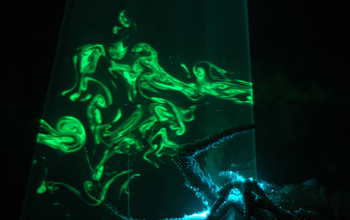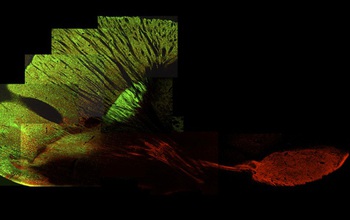All Images
News Release 16-094
NSF funds new integrative approaches to study the brain
$17 million for fundamental research in neural and cognitive systems as part of the BRAIN Initiative
This material is available primarily for archival purposes. Telephone numbers or other contact information may be out of date; please see current contact information at media contacts.

The awards stem from the cross-disciplinary NSF Integrative Strategies for Understanding Neural and Cognitive Systems program, which supports innovative, integrative, boundary-crossing approaches necessary to advance brain science.
One project, led by Matthew Reidenback of the University of Virginia, builds on recent computational modeling that shows lobsters are capable of estimating not only the concentration of odors but also the time since the last odor was encountered. Shown here is an image of dye dispersal within a laboratory flume. The lobster carapace within the flume illustrates how a lobster might search for odors within natural environments.
Credit: Matthew Reidenbach, University of Virginia
Download the high-resolution JPG version of the image. (1.7 MB)
Use your mouse to right-click (Mac users may need to Ctrl-click) the link above and choose the option that will save the file or target to your computer.

A project led by Fow-Sen Choa of the University of Maryland, Baltimore County and Mary Kay Lobo of the University of Maryland, Baltimore aims to develop and apply a non-invasive technology to modulate neuronal activity in precise brain regions, ultimately altering behavior. Development of such a technology could lead to selective non-invasive brain circuit targeting for therapeutic treatments of brain diseases. Shown here is a section of a transgenic mouse brain.
Credit: Mary Kay Lobo, Lace Riggs, and Ramesh Chandra, Department of Anatomy and Neurobiology, University of Maryland School of Medicine
Download the high-resolution JPG version of the image. (141.1 KB)
Use your mouse to right-click (Mac users may need to Ctrl-click) the link above and choose the option that will save the file or target to your computer.

The human ability to create and use technology surpasses that of any other species. How did these advanced technological skills evolve, and what can this evolutionary perspective tell us about the basis of modern human technological learning? A team of investigators from Georgia State University and Emory University will use a multidisciplinary approach to explore these questions, integrating expertise in neuroscience, informatics, anthropology, biomedical engineering, and educational psychology. Shown here is a map of the white matter connections in the human brain.
Credit: Erin E. Hecht, Center for Behavioral Neuroscience, Georgia State University
Data credit: Human Connectome Project
Download the high-resolution JPG version of the image. (130.5 KB)
Use your mouse to right-click (Mac users may need to Ctrl-click) the link above and choose the option that will save the file or target to your computer.

Neuroimaging research is increasing in volume and scope, needing big data methods for discovery. Researchers at Florida International University plan to develop an integrative metadata framework for neuroimaging to increase the research community's ability to share data and evaluate reliability in the resulting relationships between mind and brain. Shown here are differential patterns of brain activity associated with playing videogames, navigating through virtual environments, listening to music, and watching movies during MRI experiments.
Credit: Angela Laird and Katherine Bottenhorn, Florida International University
Download the high-resolution JPG version of the image. (636.5 KB)
Use your mouse to right-click (Mac users may need to Ctrl-click) the link above and choose the option that will save the file or target to your computer.
